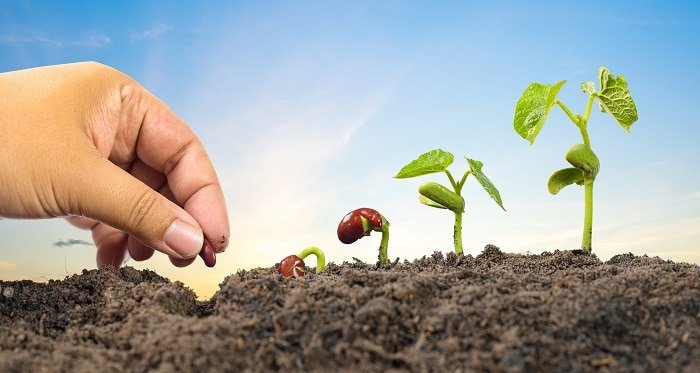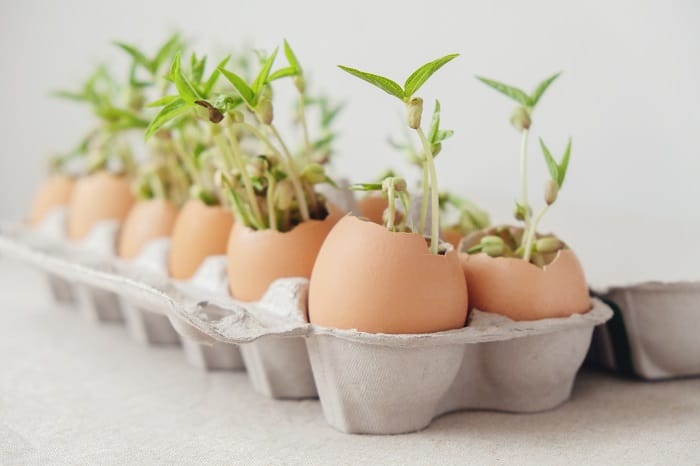When you’re into gardening, or just starting to get into it, one of the major issues you’re going to encounter is starting seeds. If you’re used to simply buying seedlings from a nearby nursery and don’t have the experience of starting seeds before, you’ll surely come across difficulties.
Trust me, I’ve been there, and I know how hard it can be, especially if you don’t use the right seed starting mix. For that, I’m here to help you know how to choose the best organic seed starting mix for your garden.
But before we start, let us first have a quick overview of the seed starting mix.
What’s a Seed Starting Mix?
A seed starting mix helps a seed germinate to a seedling then to a full-grown plant. Though you might have been used to buying seedlings straight from a nursery, the problem is that they might have plant diseases which can ultimately affect their growth and overall health.

However, by growing them from seeds via a starting mix, you will be able to control the entire process and even make sure that they remain disease-free.
To choose the best organic seed starting mix, here are some tips I’d recommend you follow:
Choose a Lightweight Mix with Excellent Drainage
To make sure you get the best organic seedling mix, you’d want to go for one that is lightweight, has excellent water retention properties, and has good drainage. This is because good water retention will allow the roots of your seedlings to push through the
It Should Contain the Right Ingredients
You also have to pay special attention to the elements that make up a seed starting mix before buying. This way, you can guarantee that your seeds will grow healthily without any issues. While the exact composition of a
Sphagnum Peat Moss
Sphagnum peat moss is considered one of the most important ingredients in a seed starting mix. In fact, most of the seed starting mixes you can find on the market contains this element which is highly absorbent and very lightweight, thereby allowing it to retain moisture which is necessary for your seeds.
Having this ingredient in your starting mix is quite beneficial if you tend to forget watering your plants on a regular basis. It also works best if you live in a dry region. The downside with the peat moss is that it will be a bit difficult to moisten.
Meanwhile, you can also opt for a coconut coir fiber as an alternative to peat moss. In fact, it’s been used in a lot of agricultural and horticultural applications. Like the peat moss, it’s also highly absorbent, capable of absorbing water up to 8 times its weight.
Diatomaceous Earth (DE)
DE is yet another key ingredient which is found in most potting mixes. It acts as a natural fertilizer which can effectively kill any insects that might affect your seeds, particularly during the germination period.
This ingredient is actually a naturally occurring mineral from fossilized plants known as diatoms. Apart from its neutralizing property, it also contains various minerals such as iron, sodium, calcium, magnesium, and silicon which are all helpful in germinating your plants.
Vermiculite
This ingredient will keep the mix moist, allowing your seeds to stay hydrated at all times. Due to that, it’s a vital ingredient which is found in most starting mixes. Like peat moss, it also saves you the trouble of having to water your seeds more often.
Perlite
The last essential ingredient you should pay attention to is perlite. Despite having a styrofoam-like appearance, perlite is actually made of small natural volcanic mineral which is responsible for its aeration and water retention capabilities. Aside from that, perlite is also ideal for preventing the mix from compacting.
Take Note of its pH Level
A
The best option is to go for a seedling mix that has a pH level of around 5.5 to 6.5. It’s because plants tend to grow best when planted in slightly acidic
However, since the ingredients added in a starting mix tend to have varying pH levels, manufacturers usually add lime in order to adjust the
Always Go Organic
While there’s still an ongoing debate whether to go for an organic or conventional seedling mix, there’s also the fact the organic products are continuing to rise in popularity. Due to a large number of consumers going “green”, most manufacturers are also starting to make the shift.

However, there are those who claim that their products are organic despite them being non-organic. As such, you have to make sure you read the fine print first before you decide on a certain seed starting mix.
Additionally, you can check the packaging for the term “OMRI Listed”. This means that the ingredients contained in said starting mix were reviewed and approved by the Organic Materials Review Institute for organic use.
FAQ’s
How Much Should I Use?
In terms of volume, most seed starting mixes are either labeled as “standard” or “light”. A standard mix will contain more than enough nutrients and moisture to get a good start. However, it can become very heavy when you put it in a pot.
On the other hand, a light mix is not as rich, but it’s easy to add additional ingredients to adjust the nutritional content as needed. The basic ratio of a seed starting mix is 1 part seed starting mix to 4 parts potting mix. You can also add more fertilizer to the mix if you wish. You should have enough soil or compost to fill your container by about two-thirds. If you don’t have any, then you will need to buy some. You can use whatever you have on hand.
What should be the first thing to consider?
The first thing you need to think about is how you’re going to use the seed starting mix. The best way to determine this is to look at what you already have available.
If you have compost, soil, peat moss or other materials, then you may be able to use them for your seed starting mix. You can also make your own seed starting mix from scratch using whatever materials you have on hand.
Do they differ a lot?
Seed starter mixes are a great way to get started with growing your own seeds. There are many different seed starter mixes available, ranging from simple to complex and with various features to help you grow your seeds. When you buy a seed starter mix, it will be made up of a number of ingredients that all contribute to the function of the mix.
There are a few types of seed starting mixes, and each one has its pros and cons. If you’re just starting out, a standard potting soil mix will probably be all you need. There are a few things to consider when choosing a seed starting mix.
What is in seed starting mix?
Seed starting mix is a mixture of soil and fertilizer. This is the best mixture to start seeds. It is also known as seed starting medium or seed germination mix.
They are often composed of peat moss, vermiculite, sand, perlite and soil. The soil should be moistened. Germination mix is a mixture of peat moss and vermiculite. This is also known as seed starting medium. It is used to protect the seeds from being damaged by the soil.
Seed starting mixes usually contain seeds of different varieties, so you can compare the germination rates of your different varieties of seeds. Mulch Some seed starting mixes contain mulch. It is not necessary, but it does help your seedlings grow better. It also keeps the roots cool.
Conclusion
If you’re keen to the idea of growing your plants from seeds, then I highly recommend going for an organic seed starting mix. After all, the fact that you can do the entire germination process on your own can be a rewarding experience.
However, just make sure that you choose your seedling mix properly. Don’t forget to refer to the above tips when buying.
If you have any questions regarding starting mixes, don’t hesitate to leave a comment below. As always, thanks for reading, and don’t forget to share it with your gardener friends.

Josephine is an enthusiastic gardener who loves to spend her spare time tending to her garden. She is passionate about growing her own food, and aspires to one day have her own vegetable garden. Josephine is also an animal lover and often takes in stray cats and dogs. She enjoys spending time with her pets in the garden, and is often seen playing with them or watering her plants. Josephine is an avid reader and enjoys learning about new gardening techniques and plants. She is always looking for ways to improve her garden and make it more beautiful. She is a great friend, always willing to lend a helping hand when needed. Josephine‘s passion for gardening and love of animals make her a wonderful addition to any garden.




